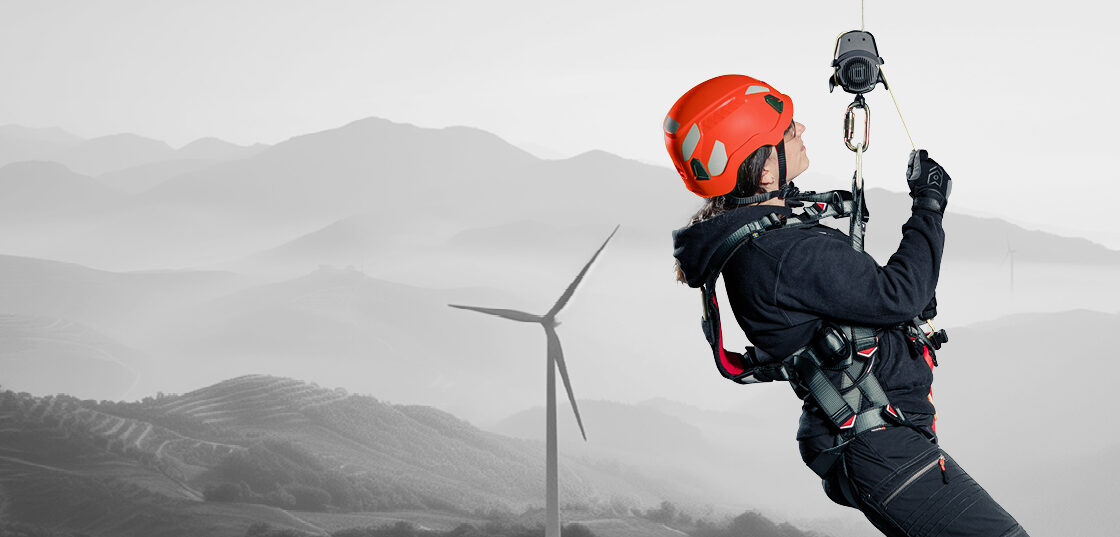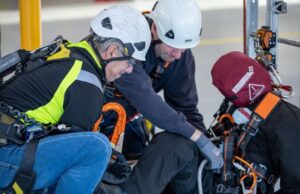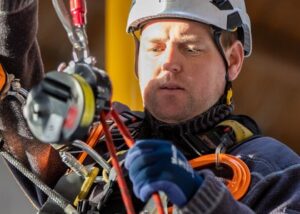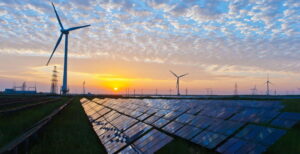A guide to personal safety for wind technicians.
The rapid expansion of wind energy has made wind technicians indispensable to the operation, maintenance, and repair of wind turbines. With turbines reaching heights of up to 300 feet (90 meters) or more, these technicians work in a high-risk environment. Their safety is paramount, and this requires a combination of Personal Protective Equipment (PPE) and rescue equipment designed specifically for their unique challenges. In this article, we’ll explore the various types of PPE and rescue equipment used by wind technicians, the pros and cons of different device types, and why it is crucial for teams to have access to a variety of rescue solutions.
The Role of PPE in Wind Turbine Maintenance
PPE serves as the first line of defence for wind technicians against potential hazards such as falls, electrical shocks, and weather-related dangers. Wind turbines are often located in remote areas where weather conditions can change quickly, increasing the likelihood of dangerous situations. Proper PPE can significantly mitigate risks and prevent accidents.
Key Types of PPE for Wind Technicians
Fall Protection Systems
- Harnesses: A full-body harness is a critical component of fall protection for wind technicians. Designed to distribute the force of a fall across the body, these harnesses are attached to an anchor point via a lanyard or self-retracting lifeline (SRL).
- Pros: Durable, adjustable, and allows freedom of movement. They are designed to prevent serious injury in the event of a fall.
- Cons: They can be uncomfortable when worn for extended periods, particularly if they are not properly fitted. Limited protection in case of secondary falls (e.g., from one platform to another).
- Self-Retracting Lifelines (SRLs): SRLs automatically retract and lock in the event of a fall, reducing the distance a technician can drop.
- Pros: Automatic locking and retraction offer rapid response in the event of a fall. Allows for greater mobility than traditional lanyards.
- Cons: SRLs can be expensive, and maintenance is crucial to ensure they function correctly. Their weight can also be a drawback when climbing tall turbines.
- Harnesses: A full-body harness is a critical component of fall protection for wind technicians. Designed to distribute the force of a fall across the body, these harnesses are attached to an anchor point via a lanyard or self-retracting lifeline (SRL).
Helmets with Chin Straps
- Helmets designed for wind technicians are lightweight, often vented, and come with chin straps to prevent them from falling off during work.
- Pros: Lightweight design reduces fatigue, and the chin strap ensures the helmet stays in place even during high-wind situations.
- Cons: Helmets need to be replaced after impact, which can be costly. Additionally, they may become uncomfortable in hot conditions without proper ventilation.
- Helmets designed for wind technicians are lightweight, often vented, and come with chin straps to prevent them from falling off during work.
Protective Eyewear
- Wind technicians work in environments with flying debris, dust, and potential exposure to harmful UV rays. Protective eyewear ensures that their vision remains unimpaired.
- Pros: Shields the eyes from UV radiation, wind, dust, and debris. Some are designed with anti-fog coatings for better visibility.
- Cons: Fogging or dirt buildup can obstruct vision, leading to distractions. Cheap models may be uncomfortable or fail to provide adequate protection.
- Wind technicians work in environments with flying debris, dust, and potential exposure to harmful UV rays. Protective eyewear ensures that their vision remains unimpaired.
Gloves
- Wind technicians rely on dexterity, so gloves must provide protection without sacrificing hand movement. Cut-resistant gloves with grip features are often preferred.
- Pros: Provides protection from cuts, abrasions, and electrical hazards. Helps maintain grip in wet or greasy conditions.
- Cons: Can reduce tactile sensitivity, making it difficult to handle small components. Poorly fitted gloves can cause hand fatigue.
- Wind technicians rely on dexterity, so gloves must provide protection without sacrificing hand movement. Cut-resistant gloves with grip features are often preferred.
Footwear
- Wind technicians wear specialized boots with slip-resistant soles and puncture-resistant materials, ensuring stability on ladders and platforms.
- Pros: Provides good traction and support. Steel toes or composite reinforcement protect against falling objects.
- Cons: Heavier boots can cause fatigue, especially when climbing turbines. Insufficient insulation can lead to discomfort in cold conditions.
- Wind technicians wear specialized boots with slip-resistant soles and puncture-resistant materials, ensuring stability on ladders and platforms.
Rescue Equipment: A Necessity in Wind Turbine Operations
While PPE can prevent many accidents, there remains a risk of incidents where a fall or other emergency occurs. Rescue equipment is designed to ensure swift, safe recovery of technicians in such scenarios. Rescue plans are mandatory for any wind turbine site, and the right equipment can mean the difference between life and death.
Types of Rescue Equipment
Rescue Kits
- Rescue kits typically contain ropes, pulleys, harnesses, and descent devices. They are designed to lower a technician to safety or bring them up from a hazardous location.
- Pros: Comprehensive and ready for use in various situations. They can be customized based on the height of the turbine and the specific working conditions.
- Cons: Heavier kits can be cumbersome to carry, and improper training can make using these systems dangerous. They require frequent inspections and maintenance.
- Rescue kits typically contain ropes, pulleys, harnesses, and descent devices. They are designed to lower a technician to safety or bring them up from a hazardous location.
Descent Devices
- These devices enable a technician to safely descend from a height in case of emergency.
- Pros: Provides a controlled descent in emergencies, reducing the risk of injury. Some models allow technicians to carry another person if necessary.
- Cons: Not all descent devices are suitable for every turbine, as the height and space constraints may differ. Additionally, incorrect use can lead to uncontrolled falls.
- These devices enable a technician to safely descend from a height in case of emergency.
Evacuation Kits
- Evacuation kits are designed to be used in extreme situations where rapid escape is necessary, such as a fire or structural failure of the turbine. The RESQ Solo X automatic personal and RESQ RedPro X are great examples of such equipment.
- Pros: Quick deployment and ease of use can help technicians evacuate rapidly in high-risk situations.
- Cons: Often designed for single-use, requiring replacement after deployment. Limited versatility compared to other rescue systems.
- Evacuation kits are designed to be used in extreme situations where rapid escape is necessary, such as a fire or structural failure of the turbine. The RESQ Solo X automatic personal and RESQ RedPro X are great examples of such equipment.
Rescue Stretchers and Backboards
- These are used when a technician is injured and needs to be transported from the turbine.
- Pros: Provides necessary support for an injured technician, ensuring their spine and neck are protected during transport.
- Cons: Requires multiple rescuers to operate, making it less efficient in situations where team size is limited.
- These are used when a technician is injured and needs to be transported from the turbine.
Winches and Mechanical Advantage Systems
- These are used to hoist a fallen or injured technician to safety.
- Pros: Offers significant lifting capacity with minimal effort from rescuers. Essential in situations where technicians need to be raised to safety rather than lowered.
- Cons: Heavier and more complex to set up. Improper use can result in rescue failure or even exacerbate the injury.
- These are used to hoist a fallen or injured technician to safety.
The Importance of a Variety of Rescue Solutions
Given the wide range of challenges posed by working on wind turbines, it is essential for teams to have access to multiple rescue options. Turbines vary in height, design, and access points, meaning that a one-size-fits-all approach is rarely effective. In addition, emergencies may differ; a technician who has fallen may require a different rescue method than one who has become incapacitated due to heat stroke or electrical shock.
For instance, a descent device may be ideal for a technician working near the top of a turbine, while a pulley-based rescue system might be necessary for those at lower levels or in more confined spaces. Access to stretchers, winches, and mechanical advantage systems allows for rapid response to a variety of situations, reducing rescue times and minimizing injury risk.
Furthermore, frequent training and drills are critical for ensuring that wind technician teams are familiar with the equipment and can respond swiftly in emergencies. Rescue plans must be customized to specific turbine sites, and teams must be well-versed in both individual and team-based rescue scenarios.
Conclusion
The safety of wind technicians relies heavily on the proper use of PPE and rescue equipment. While PPE such as harnesses, helmets, and gloves provide crucial protection during routine operations, rescue equipment is vital for responding to emergencies. By equipping wind technician teams with a variety of rescue solutions and ensuring regular training, companies can significantly reduce the risk of serious injury or death in the high-risk environments where these technicians work. The right combination of gear and preparedness is essential for maintaining safety at towering heights.
Interested in learning more?
STL USA can work with your teams on PPE and device awareness, rescue plans and processes to ensure your people have the right equipment, knowledge and training to handle even the most extreme scenarios.




